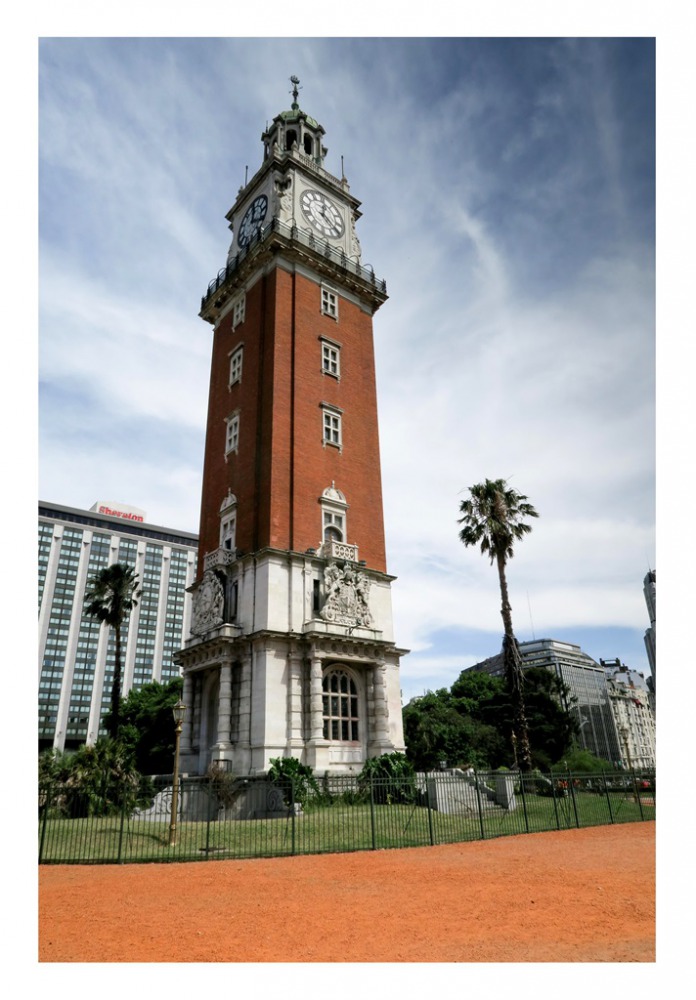
A shady umbrella on a sunny alleyway in Colonia, Uruguay, a UNESCO World Heritage site across the River Platte from Buenos Aires. Photo by Dina Mishev for The Washington Post.
BUENOS AIRES, Argentina: Last December, I had an urge to visit Europe - I wanted gorgeous architecture, a rich cafe culture, fabulous wine and cheese, wide avenues to stroll and narrow cobblestone streets to bike.
Instead of flying across the Atlantic though, I fly over the equator, to Buenos Aires, "the Paris of Latin America" where, it was explained to me when I was there in 2012, the residents are "Italians who think they're French and speak Spanish."
Yes, Buenos Aires is a longer flight from my home in Wyoming than the Paris of France, and Buenos Aires is in South America and not Europe. But, between December and April, Buenos Aires is 90 degrees and sunny; winter in Europe means rain or snow and darkness. This December was a particularly cold one for Wyoming - it is about 15 degrees below zero when I board my plane at Jackson Hole Airport - so I am willing to trade Europe for a warm, sunny European-ish city.
My travel partner is one of my best friends from high school. Our last international trip together was to the real Paris. This trip was long ago enough that I was perfectly fine sleeping on the floor of Kevin's friends, who I had never met. For six days, I happily ate nothing but crepes filled with Nutella and bananas.
Fifteenish years after our trip to Paris, Kevin and I book our tickets to the Paris of Latin America. Although Kevin is the Spanish speaker, he entrusts me, one who does not speak Spanish at all, with trip planning. Because my tastes have matured beyond Nutella crepes and friends' floors, I start with hotel and dinner reservations.
The Alvear Palace is a graciously Old World, Belle Epoque hotel in the Recoleta neighborhood. Servers at its L'Orangerie breakfast buffet wear white gloves. Placards on each floor remind guests of the dress code: In public areas, attire should be "formal or smart casual; shorts, Bermudas, or sleeveless T-shirts are not allowed. If you jog you may leave and enter the hotel in your running apparel." Bathrooms are marble with brass fixtures. The doormen wear tuxes and top hats. We will be European aristocracy, at least for several days. There is a personal butler.
Conveniently, one of the restaurants I want to eat at, La Bourgogne, is in Alvear Palace's basement.
Two blocks from Alvear Palace is Palacio Duhau, designed as a family home in the early 1930s by French architect Leon Dourge in the style of the Chateau des Marais, a neoclassical palace outside of Paris.
In 2006, after extensive restoration work and the addition of a 17-story modern tower, it opened as a Park Hyatt. Sitting in front of my computer in Wyoming, scanning the hotel's website, it doesn't take much imagination to transport myself to its outdoor patio, which overlooks the city's largest private garden, for afternoon tea. I also make a reservation for a cheese tasting at the hotel's Vinoteca, where the city's only maitre fromager works.
While Recoleta might be one of Buenos Aires' most European-feeling neighborhoods, we do want to explore the wider city. Our first activity will be a seven-hour, guided bike tour.
To immediately get us into a Euro state of mind, I insist that Kevin and I walk from Alvear Palace to Biking Buenos Aires' storefront in the San Telmo neighborhood, one of the city's oldest.
We're late because I can't stop taking pictures of the architecture. (Also because I misjudged the distance we would have to walk.) At one intersection of two cobblestone streets, buildings range from Edwardian to Brutalist, Beaux-Arts and Art Deco. Maybe planning an architecture tour is in order.
- - -

In our first hour with bike guide Pepe Rivas, we pedal down narrow, one-way stone streets and on designated bike lanes along the edges of wide, leafy avenues. We ride through Lezama Park, which, with its numerous sculptures and large esplanade, where two couples are making out, feels decidedly European. This makes sense when Rivas tells us that, at the turn of the 20th century, it was a French-Argentine landscape architect who remodeled the park's original design.
Lezama's jacaranda and rosewood trees pull me back to South America, as does a massive monument honoring Spanish conquistador Pedro de Mendoza, who founded Buenos Aires in 1536.
I watch groups of men pass around cups of mate, a caffeine-rich tea made from ground leaves of the yerba mate tree and designated by the Argentine Senate as the country's "national infusion." It is easy to recognize people drinking mate because it is always drunk out of a very specifically sized and shaped "mug" - actually a hollowed-out gourd - and through a metal straw called a bombilla.
We pedal past La Bombonera stadium, home to the Boca Juniors soccer team, whose colors are those of the Swedish flag - blue and gold. Rivas tells us what I'm sure must be a tall tale - that, over a century ago, after losing a game against a team wearing similar colors, Boca promised to adopt the colors of the flag of the next ship arriving at the nearby port. Fact-checking Rivas's story later, I find it to be true.
In Caminito, an area of La Boca settled mainly by immigrants from Genoa in the early 1900s and today popular with tourists because of its abundance of Italian restaurants and the colorful facades of its wood houses, the air smells like southern Italy - anchovies and olive oil. Here in a small park kitty-corner from a number of women dressed in tango outfits that pose for photos and then demand several pesos, we take a break for a mate lesson. "To understand Argentina, you must understand mate," Rivas says, and then he makes a gourd-full for us.
To Kevin and me, its taste is as bitter as Rivas's preparation of it is precise. Rivas assures us it won't take long for us to acquire a taste for it.
Since we do so poorly with the national infusion, Kevin and I double down on the Senatedecreed national drink: Argentine wine. We are committed even though our first opportunity to drink wine is at the Frenchiest of Buenos Aires' French restaurants.
Before I can worry whether it's acceptable to order non-French wine at La Bourgogne, I worry whether our clothes make the cut of the restaurant's dress code. Male diners are supposed to wear sport coats. Not being a banker nor a diplomat, Kevin didn't pack one. The only reason I'm appropriately dressed is because our personal butler arranged for my wrinkled clothes to be pressed. It turns out that Kevin's button-down shirt is just fine.
Seated, it's quickly apparent that it's okay to order non-French wine here. The red leather-backed wine menu includes bottles from around the world, even Israel. It might just be the Frenchy formality of the atmosphere - waiters in tuxes, the table's small crystal vase with three pink roses or the hushed tones of our fellow diners - but I swear the glass I start with, a sparkling wine from Mendoza called Cavas Rosell Boher Cuvée Millésimé, has notes of brioche.
I don't know it at the time, but La Bourgogne's black pepper beef tenderloin flambéed tableside with cognac is the best beef I'll have all week.
And this dinner is the best meal of the week until my last day, when lunch is high tea on the Park Hyatt's patio and dinner is a tasting/pairing of four cheeses and four wines at the hotel's Vinoteca. (Not as uninspired and unadventurous as banana-Nutella crepes, but probably about as healthy.)
The tea experience is even better than I had imagined back during the planning stages. The tea blend has hints of lavender, vanilla and rose. A raspberry macaron is nearly the diameter of a doughnut. I am sitting on the actual patio of an actual Louis XVI-style palace. And I'm grateful for the shade of giant rubber trees because it is December and the sun is out and warm.
If you go
Where to stay
Palacio Duhau Park Hyatt Buenos Aires
Av. Alvear 1661
011-54-11-5171-1234
buenosaires.park.hyatt.com
Choose from 23 rooms in a 1934 mansion that was modeled after the Chateau des Marais outside Paris, or 169 rooms and suites in the hotel's adjacent 17-story building, which was completed in 2006. Rooms from $550.
Alvear Palace Hotel
Av. Alvear 1891
011-54-11-4808-2100
alvearpalace.com
A resplendently opulent - crystal chandeliers, gold leaf, marble, white-gloved waiters - historic hotel with 206 rooms and suites in one of the city's fanciest neighborhoods. Rooms from $480.
CasaCalma Wellness Hotel
Suipacha 1015
011-54-11-4312-5000
casacalmahotel.com/en/home
A centrally located boutique hotel that offers a peaceful, quiet breakfast buffet option (which you can also bring up to your room) and a lobby with a living wall. Rooms from $235.
Where to eat
La Bourgogne
Av. Alvear 1891
011-54-11-4808-3857
alvearpalace.com/v3/eng/la-bourgogne.php
Sublime French food and service - some say the city's best - in a formal setting. Dinner entrees from $16. Three-course fixed menu with wine is $60.
Cafe Tortoni
Av. De Mayo 825
011-54-11-4342-4328
cafetortoni.com.ar/en
Come for the history (opened in 1858) and decor - Tiffany glass ceiling, marble tables, dark wood columns and wood paneled walls - rather than the average cafe con leche and churros con chocolate. Treats from $3.
Rodi Bar
Vicente Lopez 1900
011-54-11-4801-5230
A cozy local restaurant with fresh pasta and solid steaks in the Recoleta neighborhood. Entrees from $10.
What to do
Wine and cheese tasting
Duhau Restaurante & Vinoteca
1661 Av. Alvear
011-54-11-5171-1340
buenosaires.park.hyatt.com
The city's only "maitre fromager" (a certified cheese authority) works with a sommelier to pair regional cheeses with Argentine wines. Pairings from $41 (two cheeses and two wines).
Architecture city tour with Martín Marimón
011-54-11-5045-2643
gydeandseek.com
Customized tours in English, Spanish or German from a Porteño working on his PhD (from Princeton) in history and Latin American studies. $80 for a two-hour walking tour for up to four people.
Theater tour
Teatro Colón
Cerrito 628
011-54-11-4378-7100
teatrocolon.org.ar/en
Guides explain this 109-year-old building's eccentric architecture and superb acoustics in 50-minute long tours that start every 15 minutes daily between 9 a.m. and 5 p.m.
Tango performance
El Viejo Almacén
Av. Independencia 299
011-54-11-4307-7388
viejoalmacen.com.ar/EN/index.html
Classic and contemporary tango performances done to live music in a historic space in the Sal Telmo neighborhood. A traditional show with two drinks starts at $90, dinner show at $140.
Information
turismo.buenosaires.gob.ar/en
Mishev is the editor of Inspirato magazine.





